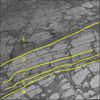
Figure 1This image shows the area inside "Endurance Crater" that the Mars Exploration Rover Opportunity has been examining. The rover is investigating the distinct layers of rock that make up this region. Each layer is defined by subtle color and texture variations and represents a separate chapter in Mars' history. The deeper the layer, the further back in time the rocks were formed. Scientists are "reading" this history book by systematically studying each layer with the rover's scientific instruments. So far, data from the rover indicate that the top layers are sulfate-rich, like the rocks observed in "Eagle Crater." This implies that water processes were involved in forming the materials that make up these rocks.
In figure 1, the layer labeled "A" in this picture contains broken-up rocks that most closely resemble those of "Eagle Crater." Layers "B,C and D" appear less broken up and more finely laminated. Layer "E," on the other hand, looks more like "A." At present, the rover is examining layer "D."
So far, data from the rover indicates that the first four layers consist of sulfate-rich, jarosite-containing rocks like those observed in Eagle Crater. This implies that water processes were involved in forming the materials that make up these rocks, though the materials themselves may have been laid down by wind.
This image was taken by Opportunity's navigation camera on sol 134 (June 9, 2004).

